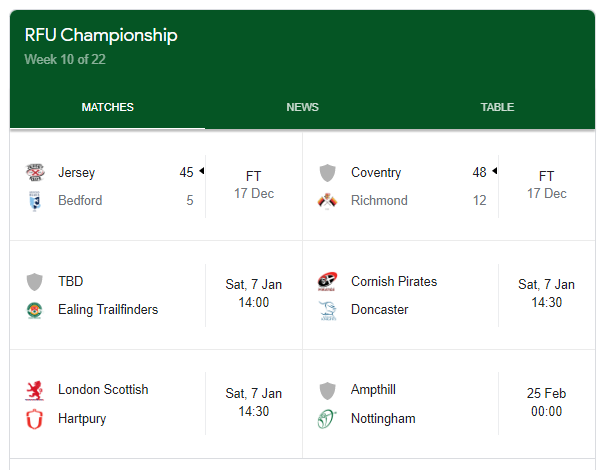Though many top-tier rugby competitions exist, few, if any, compare to the Gallagher Premiership in terms of quality, scope, or following. The competition has been a shining example of excellence and consistency since its inception in the late 1980s. Some rugby historians and fans even argue that it was the template against which other top-flight rugby competitions in the northern and western hemispheres like France’s Top 14 and the multinational United Rugby Championship are based on. Core to its success has been its lower “feeder” leagues which ensure that the Gallagher Premiership remains competitive year in and year out.
What league is below the Gallagher Premiership? The Rugby Football Union (RFU) championship is the league below the Gallagher Premiership. The competition has been the second tier in the English rugby union hierarchy since it was last reconstituted in the late 2000s and consists of 12 clubs of both professional and semi-professional players who battle it out for the league’s top prize – the Championship Cup – and promotion to the Gallagher Premiership every season.

A Brief History
In order to fully appreciate tier rugby in England, one needs to first take stock of the events that led up to its establishment. Many codes of football existed through the ages in England including antecedents of what would later come to be known as rugby football.
Historians of the sport agree that the sport first gained its identity in 1823 when a student at Rugby School which is located in Warwickshire, England, went against the norms of the style of football that existed at the time and decided to pick up the ball and run with it during a game.
The student, who was named William Webb Ellis, became the forefather of the sport and started a tradition at the public school which was adopted and later became part and parcel of their tradition. Future students at the school later drafted the first set of widely-recognized rules of the sport that would later come to be known as rugby union football in 1845.
As the alumni of the school progressed to higher institutions of learning, they took the sport and the rules they observed with them leading to the spread of the sport across England. Graduates of the above-mentioned institutions of higher learning went on to form the first football clubs along with other members of other institutions who brought along their own rules which blurred the lines between rugby and soccer.
In order to find a consensus on where the rules were concerned, a series of meetings were convened by a number of the leading football clubs at the time in 1863 which birthed the Football Association (FA). Disputes quickly followed regarding some of the rules practiced by clubs who preferred the rugby form, particularly handling of the ball and hacking (tripping an opponent and/or kicking at his shins).
After failing to find the middle ground, the clubs that preferred the rugby form broke away from FA and later formed the Rugby Football Union (RFU) in 1871. Unlike their soccer counterparts who warmed up to the idea of professionalism, the RFU fiercely resisted it – a decision that did not sit well with northern rugby clubs which were largely made up of working-class players.
Introduction of Tier Rugby
The matter of compensation for working-class players who had to take time off work to play rugby was tabled as a motion at an RFU general meeting in 1893. The motion was however soundly defeated since southern clubs had the larger share of deciding votes in the union.
Dissatisfied with the decision, 22 of the leading northern clubs resigned from the RFU in August 1985 to form the Northern Rugby Football Union (NRFU) which later became the Rugby Football League in 1922.
Along with professionalism, the RFU also strongly discouraged the formation of leagues since they believed that it would encourage the adoption of practices that went against amateurism and force clubs to pay players so as to have better chances of success.
Rugby clubs took the initiative and began organizing fixtures between them in the years leading up to the 1970s. Two tournaments were later established – the County Cups and County Championship for rugby clubs and country representative teams respectively.
Sensing a change in the tide, the RFU followed suit and founded the RFU Club Competition in 1972. Clubs were later organized in regional and national merit tables which distorted the previous order and necessitated the creation of a league system in 1987.
The Evolution of the RFU Championship
The RFU Championship started out as the Courage League National Division Two in their 1987-88 season. Like their Courage League National Division One counterparts, second-tier clubs were required to arrange their own fixtures for their maiden season before the RFU took over the allocation of matches in their second season.
The increased frequency and level of competition prompted the league, its players, and the sport of rugby, in general, to grow exponentially in the following years. This development led to the establishment of a full schedule of home and away matches in 1994. The second tier retained its Courage League National Division Two name until its 1996-97 season, which is also the first season the league turned professional.
After a soft rebranding, the second tier came to be known as the Allied Dunbar Premiership Two from its 1997-98 season to its 1999-2000 campaign. The league adopted the name National Division One from 2000-01 to 2008-09.
Plans to establish the current RFU Championship were instituted by the RFU in November 2008 when they made known plans to reorganize the former 16-team National Division One into a 12-team Championship by relegating five clubs to a third tier at the end of their 2008-09 campaign.
Recent Developments and Future Plans
Though the initial intention for the establishment of the RFU Championship was to promote high-level competition through a promotion and relegation system with the Gallagher Premiership, that has not always been the case.
Rather than solely relying on automatic promotion, the league applies a system that involves a playoff tournament to decide which RFU Championship team gets promoted to the top flight. The playoff tournament was utilized from the 2009-10 to 2016-17 seasons.
Their 2017-18 to 2019-20 seasons saw the temporary introduction of automatic promotion. The league then reintroduced the playoff tournament for their 2020-21 season but set plans in motion to review the minimum criteria for promotion and relegation to and from the Premiership and RFU Championship respectively.
The said plans suspended relegation from the Championship in their 2021-22 season and intend to reintroduce promotion to their Premiership beginning from the end of their 2023-24 season by creating a playoff between the bottom Premiership team and the top Championship club with the winner ascending to the top-flight and the loser descending to the second tier.
